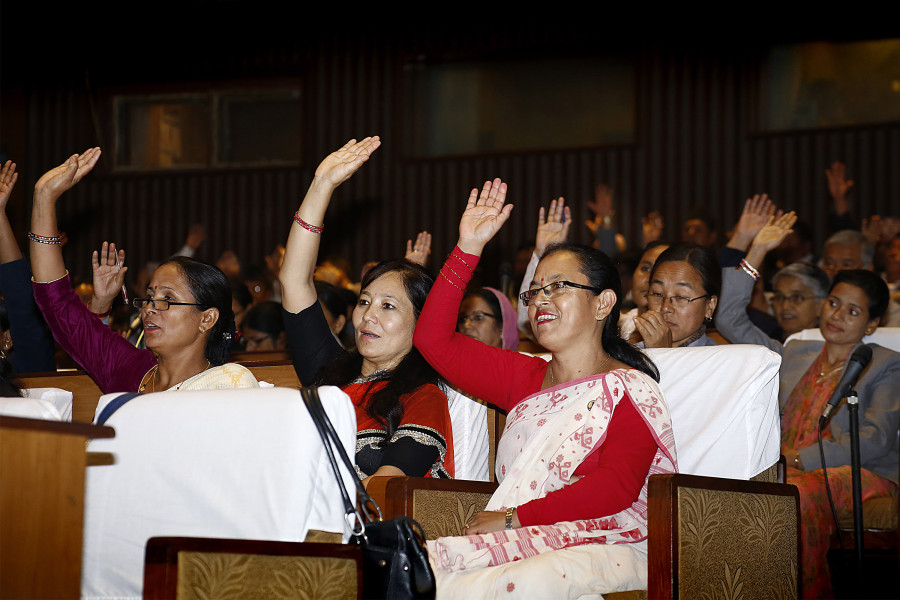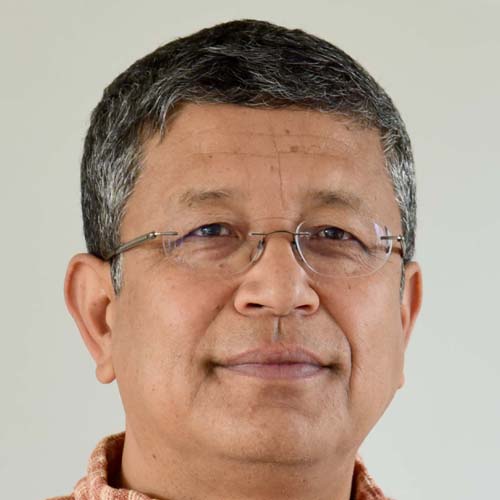Columns
Of women and strongmen
Hardly have women begun to creep to the top and men already think women have too much power.
Deepak Thapa
At a public function a couple of days ago, former vice-chair at the National Planning Commission, Biswo Poudel, reminisced on his time in office to note the inertia that generally afflicts governments. He was reflecting on resistance within our bureaucracy towards initiatives aimed at supporting women in the multifarious ways that only a government can. What was astounding, but not wholly surprising, was what a male official reportedly told him “man-to-man”, and I use Poudel’s words here: “Women have too much power.”
Such attitudes are only indicative of how much more needs to be done—to change the mind-set of those in positions of authority. It was only after the 2007 amendment to the Civil Service Act and near-concurrent electoral laws guaranteeing reservations to women that we began to see some improvement in the sex ratio in government. The source of the male angst appears to be the resultant higher presence of women in government offices and as elected representatives from top to bottom.
Positive discrimination
Let’s deal with the civil service first. Publicly available data shows that since the introduction of quotas in 2007/08, 14 percent of the new inductees in the “reserved” category have been women. The data does not say what percentage of the total, the “open” category included, were women, but based on last year’s figures, we can assume it to be somewhat substantial. Of the women contingent comprising 30 percent of the entire intake, fewer than half were from the quota pool. It is thus becoming clear that reservations or not, the number of women in government service will only continue to rise.
It is not all hunky-dory though. The data cited above provides no breakdown of the different levels women are employed in. One source from 2015, eight years after the quotas were introduced, paints a rather dismal picture, with 85 percent of the women civil servants concentrated in the non-gazetted and “classless” categories, i.e., at the very bottom of the hierarchy. Such a situation persisted despite the many provisions in place to encourage more women to join the government, including relaxation of the age limit, shorter probations, and quicker promotions.
Considering the higher visibility of women—such as in the Nayapatrika report last year that there were nine women CDOs at the time—the ground would have shifted by now. And, if the federal civil service act being considered by Parliament gets through, the proportion of places reserved for women will go up to a full quarter from the current 15 percent. Most importantly, it will also put in place reservations for other marginalised groups within the women’s quota. No wonder men like Poudel’s interlocutor above feel the need to push back.
Women on top
Much has been written about the high presence of elected women representatives at all levels of government in Nepal. Despite some setbacks at the local level in 2022 and the naysayers who view these women only as tokens, we as a nation can justly be proud of such a large cohort of women getting ready to take on leadership roles in the future. For evidence from elsewhere shows that regardless of how they entered politics, over time women will come into their own.
Which brings me to an interesting report published recently by the Pew Research Center, an American think tank. With an unwieldy title, “Representative Democracy Remains a Popular Ideal, but People Around the World Are Critical of How It’s Working” is based on a survey conducted in 24 countries around the globe. Nepal, unfortunately, is not important enough to be included in such studies. But India was, and I think we can make some extrapolations based on what the Indian respondents said.
Among the remarkable results of the Pew study was the perception of what it would mean if more women were in elected office. A median of 50 percent in the 24 countries said policies would improve while just 8 percent said the opposite. In India, the proportions were 68 and 11 percent, respectively, the highest level of confidence in female leadership among all the countries. Although there may not be a perfect causality, our better showing in the gender gap index compared to India’s, would probably have led to our numbers to be similar if not higher. All the reason to call for more power to women.
Strongman fantasy
There were two other findings from the Pew survey worth noting here. One was how people looked at political parties. The median figures for the 24 countries were that 74 percent believed the parties do not care about people, while in India it was 54 percent. I have a feeling our own views would be closer to the median than India’s.
The other was what people thought about autocracy even if the Pew question was couched in terms of a leader or system unencumbered by parliament or the courts. In India, support for such a strong leader was as 67 percent in 2023, up 12 percentage points from a similar survey in 2017. Taking into account Narendra Modi’s thus-far-unassailable popularity and the somewhat skewed perception that he has delivered where others have failed, these numbers are not totally unexpected.
One does wonder how Nepalis would have responded. There has always been loose talk hankering for a strong leader, and there are enough among the conservatives who would have us believe that the discredited former king, Gyanendra, is one such candidate to take on that mantle. While the Pew report notes that “the ideological right are often more likely than those on the left to support rule by a strong leader”, I think given state dysfunction at various levels, there are many on the left who feel equally drawn to the idea of a benevolent autocrat even if they might not share the same enthusiasm about the former royal.
In the introduction to a book he edited, Men at War: The Best War Stories of All Time, Ernest Hemingway had written: “For many years you heard American people speak who admired Mussolini because he made the trains run on time in Italy. It never seemed to occur to them that we made the trains run on time in America without Fascism.”
I first read those lines as a school kid. I had been drawn to the book by its title and the Hemingway imprimatur, and I did not really know much about fascism or democracy even though we were experiencing a brief period of relatively free speech in the run-up to the 1980 national referendum. But that pithy observation of Hemingway’s has stuck with me over the decades. Much later, I learnt that trains running on time in Mussolini’s Italy was partly a fiction perpetuated by “well-heeled British tourists who considered the hopelessly refractory Italians governable only by dictatorial means”. I certainly hope that the yearning for strongman rule in some quarters is not an admission of a similar refractoriness among us.




 6.84°C Kathmandu
6.84°C Kathmandu















